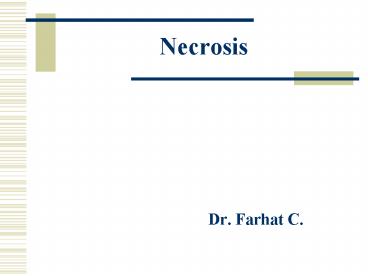Necrosis - PowerPoint PPT Presentation
1 / 25
Title: Necrosis
1
Necrosis
- Dr.
Farhat C.
2
Necrosis
- Sequence of morphological change that follow
- cell death in living tissues
- Irreversible exogenous injury
3
- Necrosis is defined as focal death along with
degradation of tissue by hydrolytic enzymes
liberated by cells. - It is invariably accompanied by inflamatory
reactions.
4
Causes
- Hypoxia
- Chemical and physical agents
- Microbial agents
- Immunological agents
5
Two Essential Changes Cause Irreversible Cell
Injury
ENZYMATIC DIGESTION OF CELL
DENATURATION OF PROTEIN
- HYDROLYTIC ENZYMES
- AUTOLYSIS
- HETEROLYSIS
6
Morphologically App
- Increase Eosinophilia
- (binding of eosin denatured intra
cytoplasmic proteins. ) - Homogenous appearance
- Nuclear changes non-specific breakdown of DNA
- PYKNOSIS
- KARYOLYSIS
- KARYORRHEXIS
7
- DENATURATION occur as primary pathology in the
coagulative necrosis - dominant enzyme digestion (liquefaction Necr)
- Some other circumstances ---- caseous necrosis
- ---- fat necrosis
8
Coagulation necrosis
- Causes ischaemia
- bacterial agents
- chemical agents
- Commonly affected heart, kidney, spleen.
9
COAGULATIVE NECROSIS
Preserve basic structural outline , injury cause
-- acidosis --denaturation of structural
enzymatic
proteinsblockage.
Myocardial infarction acidophilic, anuclear,
coagulate leads- necrosis Debris which remain
after necrosis fragmentation phagocytosis
10
(No Transcript)
11
Coagulative Necrosis
- G/A Early stage pale firm and later on yellowish
softer and shrunken. - M/E -- tombstones (ie)outline of cell retain but
there cytoplasmic and nuclear details are lost.
12
Coagulative necrosis
ischemia and infarction (loss of blood supply and
resultant tissue anoxia) there is a wedge-shaped
pale area of coagulative necrosis (infarction)
in the renal cortex of the kidney.
13
LIQUEFACTION NECROSIS
- Commonly due to ischemic injury and bacterial or
fungal infection,accumulation of WBC. - Powerful hydrolytic enzymes
- Brain infarct and abscess
- G/AAREA is soft liquefied center containing
necrotic debris and wall is formed - M/ECyst Wall Is Formed by proliferative
capillaries, inflammatory cell and gliosis
(brain) and proliferating fibroblast in abscess.
14
Caseous necrosis
- Centre of foci of tuberculous infections.
Coagulative and liquefactive. - G/A dry cheese like, soft granular, yellowish
- M/E
- Structreless, Eosinophilic, Granular debris,
- Surrounding tissue- characteristic granulomatous
inflammatory reaction - (histotoxic effect of lipopolysccharides present
in the capsule of tubercle bacilli) -
15
Caseous necrosis
Caseous necrosis, with confluent cheesy tan
granulomas in the upper portion of this lung in a
patient with tuberculosis.
16
gross appearance of caseous necrosis in a hilar
lymph node infected with tuberculosis. The node
has a cheesy tan to white appearance
17
Fat necrosis
- Two location following acute pancreatic necrosis
or truamatic necrosis. - Liberation of pancreatic lipase
- Hydrolysis of neutral fat in adipose tissue into
glycerol free fatty acids. Combine to calcium to
form calcium soaps, (saponification)
18
- G/E yellowish white and firm deposit.
- Formation of calcium soaps chalky white
appearance. - M/E cloudy appearance surrounded by an
inflammatory reaction , formation of calcium
soaps is identified in section as amorphous,
granular, basophilic material.
19
Fat necrosis
fat necrosis of the pancreas
20
(No Transcript)
21
Fibrinoid necrosis
- deposition of fibrin like material which stain
like fibrin, - E.g immunologic tissue injury, immune complex
vasculitis, arterioles in HTN, peptic ulcer, - M\e brightly eosinophilic, hyaline like
deposition in vessels. - Local haemorrhage.
22
Therapeutics
- Belladonna
- Arsenic album
- Fluoric Acid
- Bacillinum
- Aurum met
- Calc flur
- Merc
- Hepar sulp
- Iod
- Nat sil
- Nit acid
- Phos
- Phos A
- Cal
23
BACILLINUM
- Has been employed successfully in the treatment
of tuberculosis - its good effects seen in the change of the
sputum, which becomes decreased and more aerated
and less purulent. - Many formsof chronic non-tubercular disease are
influenced favorably - by Bacillinum, especially when
bronchorrhoea and dyspnoea are present.
Respiratory pyorrhoea. - The patient expectorates less.
- Bacillinum is especially indicated for lungs of
old people, - with chronic catarrhal condition and enfeebled
pulmonary circulation, attacks of suffocation at
night with difficult cough. - Suffocative catarrh. Tubercular meningitis.
- Favors falling off of tartar of teeth. Constant
disposition to take cold.
24
Fluoric Acid
- Syphilitic mercurial dyscrasias, abuse of mercury
or silica - CARIES of bones. Necrosis.
- Painful VARICOSE VEINS.
- Felon.
- Rheumatic pains.
- UNCOVERS FEET AT NIGHT IN BED (Med, Puls,
Sulph). - - Abscess. Fistulas.
- - Hard, horny skin and eruptions (Ant-c,
Graph). Epithelioma. - - Bedsores, lt warmth.
- - Itching in spots of orifices.
- - Itching, redness, painfulness of
cicatrices which become red around edges and
threaten to become open ulcer.
25
Aurum Met
- Syphilitic and mercurial affections of bones.
- Caries with excessively foetid discharge.
- Pains lt night, drive to despair.
Extremities.-Pain as from ulceration in finger
tips. Shooting and - tearing in tips of finger and toes. Ulcerative
pain in heels. - Neuralgic pain in amputated limbs. Offensive
sweaty feet. - Skin.-Itching, generally evenings. Blisters on
various parts. - Intense burning better cold applications.

